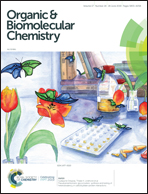Solvent-free ruthenium-catalysed triflate coupling as a convenient method for selective azole-o-C–H monoarylation†
Abstract
Metal-catalysed ortho-directed C–H functionalization usually faces selectivity issues in the competition between mono- and disubstitution processes. We report herein the ruthenium-catalysed N-directed C–H monoarylation of arylpyrazoles with a selectivity of up to 96% or that generally reaches values above 80%. This selectivity is an effect of solvent-free conditions associated with sulfonate reagents, in the absence of frequently used acidic additives.

- This article is part of the themed collection: Direct C-H Functionalization in Method Development and Late Stage Functionalization


 Please wait while we load your content...
Please wait while we load your content...